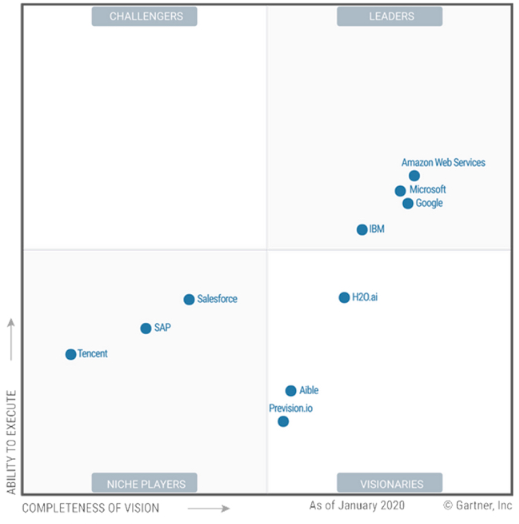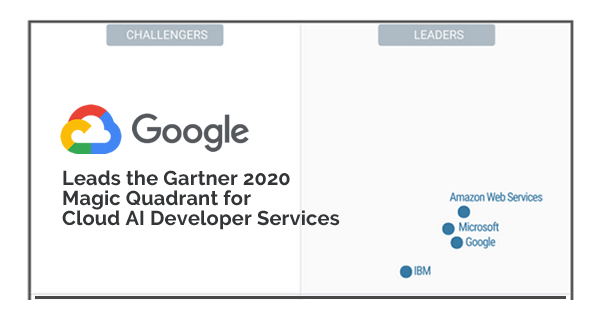The cloud offering of Google i.e. Google Cloud Platform has achieved yet another laurel by becoming a leader in the Gartner 2020 Magic Quadrant for Cloud AI Developer Services report. Enterprise-level applications of machine learning and artificial intelligence continue to develop and expand with every passing day.
Therefore, developers, data scientists, analysts, and anyone interested in artificial intelligence look for an ideal platform that allows them to make the most of AI and ML technologies.
What Made Google Cloud a Leader in the Gartner 2020 Magic Quadrant?
The report by Gartner prepared with dedicated efforts by expert analysts serves a vital resource for understanding why Google outperformed other cloud platforms. Gartner evaluated the different products of Google, such as conversation, language, vision, and structured data products delivered through Google Cloud services.

-
Delivering Simplicity to AI and ML Professionals
According to the Gartner 2020 Magic Quadrant for Cloud AI Developer Services report, Google Cloud provides exceptional simplicity. Users don’t need profound fluency in machine learning for using the products in Google Cloud’s AI portfolio. Developers can leverage the vision and video APIs along with AutoML Vision and Video products for building perception AI into applications. The Computer Vision products of Google Cloud also offer unique features for understanding visual content and the creation of sophisticated custom ML models.
Vision API utilizes REST and RPC APIs for providing you with access to pre-trained models for faster classification of images.
AutoML Vision product helps in automation of the process for training your personal custom ML models. In addition, users can leverage AutoML Vision for optimizing models to achieve the desired accuracy, size, and latency. Users can also export the ML models to applications in the cloud or a collection of devices at the edge.
Video Intelligence API provides pre-trained ML models for automatic recognition of multiple objects, actions, and places in video content.
AutoML Video Intelligence is an ideal tool for faster and simpler training of custom models for classification and tracking of objects in videos.
What-If Tool, the open-source visualization tool helps in the inspection of ML models, thereby improving the interoperability of the model. In addition, it can also provide unique insights on decisions for data-labeling and AutoML Vision services.
Google Cloud also offers flexible options for the deployment of pre-trained models according to the requirements of a business. Developers can deploy AutoML Vision models through the container on any platform that works for them. Developers have the option of choosing virtual private cloud, the Google public cloud, or on-premises deployment of AutoML Vision models.
Also Read: Google Cloud Platform Cheat Sheet
-
AutoML Tables: The Biggest Differentiator for Google Cloud
The AutoML Tables in Google Cloud serve flexible and efficient tools for automatic creation and deployment of state-of-the-art ML models for structured data. Developers, analysts, and data scientists don’t have to worry about the speed and scale of the deployment with AutoML Tables.
In addition, AutoML Tables also provide information and ensure automatic management of higher cardinality, distribution for each feature, and missing data in the data set. During the training process, it helps in automation of many feature engineering tasks such as normalization of numeric features, embeddings for categorical features, and creating one-hot encoding.
The codeless GUI and Python SDK options with AutoML Tables are also some of the notable highlights for Google Cloud. In addition, users could also find feature engineering, automated data preprocessing, and deployment functionality with AutoML Tables. These features help in bringing a custom ML model to production quicker.
-
Google Cloud’s Support for Global Expansion
Google Cloud also recognizes the need for global expansion of businesses in its Cloud AI Developer services. Users could find different Google Cloud products with support for more languages than other providers.
OCR Language Support of Google Cloud can count more than 200 languages.
Speech-to-Text product of Google Cloud provides support for around 120 languages and variants.
Similarly, the Translation Product of Google Cloud supports 104 languages, and the Chatbot Product supports more than 20 languages with the possibility of adding more languages in the future.
Therefore, Google Cloud is definitely a viable option for the global scaling of a business.
Bottom Line: Another Notable Feat by Google Cloud
So, it is clearly evident that Google Cloud has rightly earned its position as the leader in the 2020 Magic Quadrant for Cloud AI Developer Services report by Gartner. As enterprises recognize the importance of AI and ML and increase their adoption, Google Cloud becomes a favorable option.
Another interesting fact about Google Cloud is that it is not only a leader in providing Cloud AI Developer services but also a leader in Data Analytics Management.
Google Cloud also obtained the tag of a “leader” in The Forrester Wave: Data Management for Analytics (DMA) report for the first quarter of 2020. The report evaluated the broader data analytics portfolio of Google Cloud, including BigQuery as the highlight product.
Google Cloud scored top marks in various categories in the report and validated the efficiency of the data analytics strategy of Google Cloud. The report by Forrester considered different categories for evaluation of Google Cloud’s Data Analytics capabilities such as roadmap, availability, data storage, customer use cases, scalability, performance, data security, and data ingestion.
- Top 20 Questions To Prepare For Certified Kubernetes Administrator Exam - August 16, 2024
- 10 AWS Services to Master for the AWS Developer Associate Exam - August 14, 2024
- Exam Tips for AWS Machine Learning Specialty Certification - August 7, 2024
- Best 15+ AWS Developer Associate hands-on labs in 2024 - July 24, 2024
- Containers vs Virtual Machines: Differences You Should Know - June 24, 2024
- Databricks Launched World’s Most Capable Large Language Model (LLM) - April 26, 2024
- What are the storage options available in Microsoft Azure? - March 14, 2024
- User’s Guide to Getting Started with Google Kubernetes Engine - March 1, 2024

